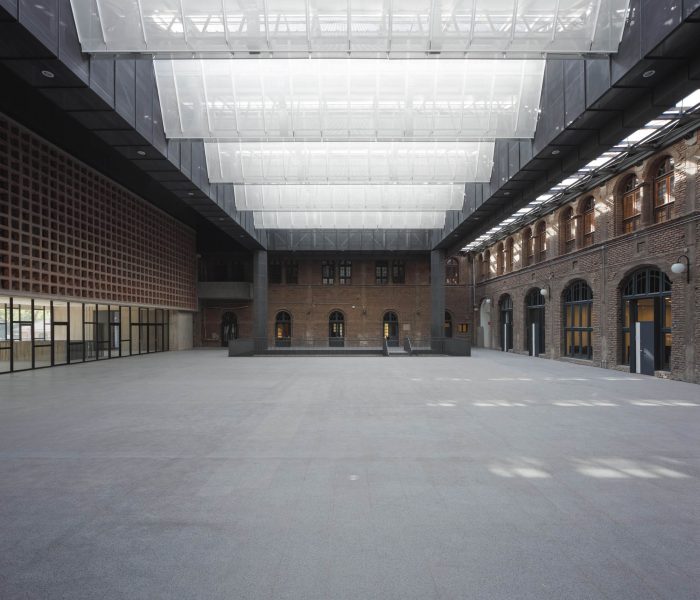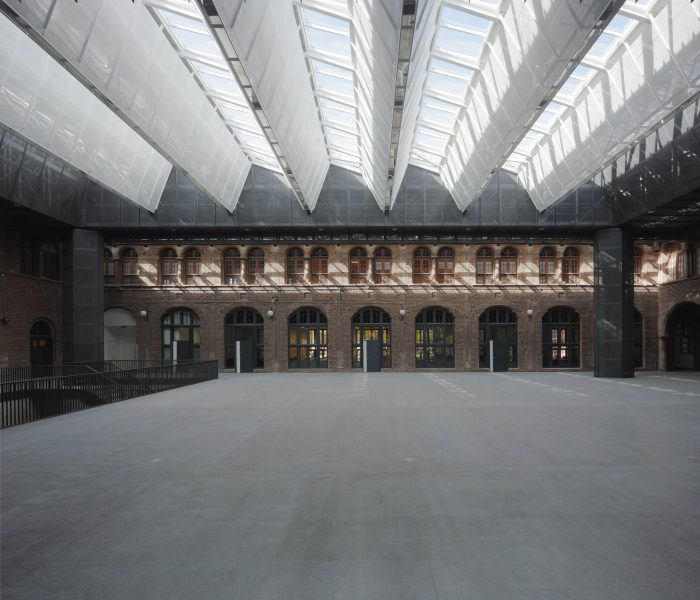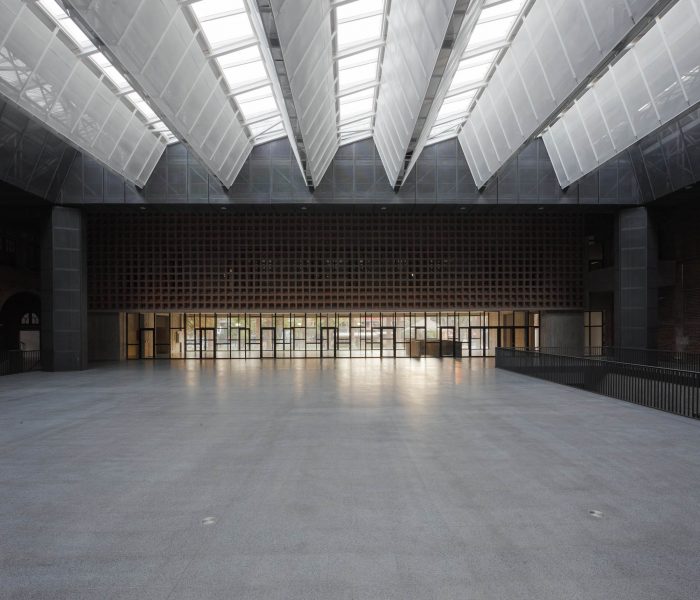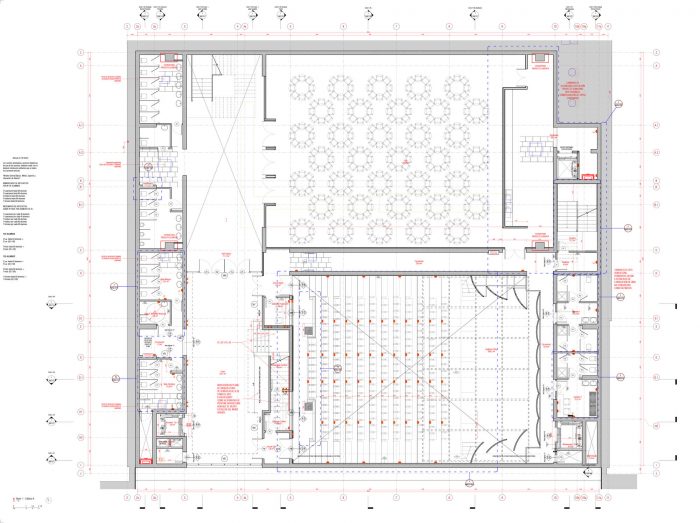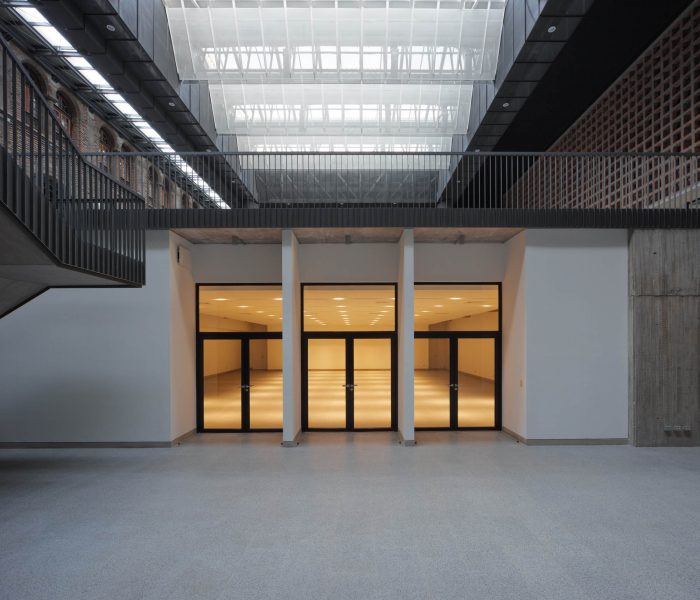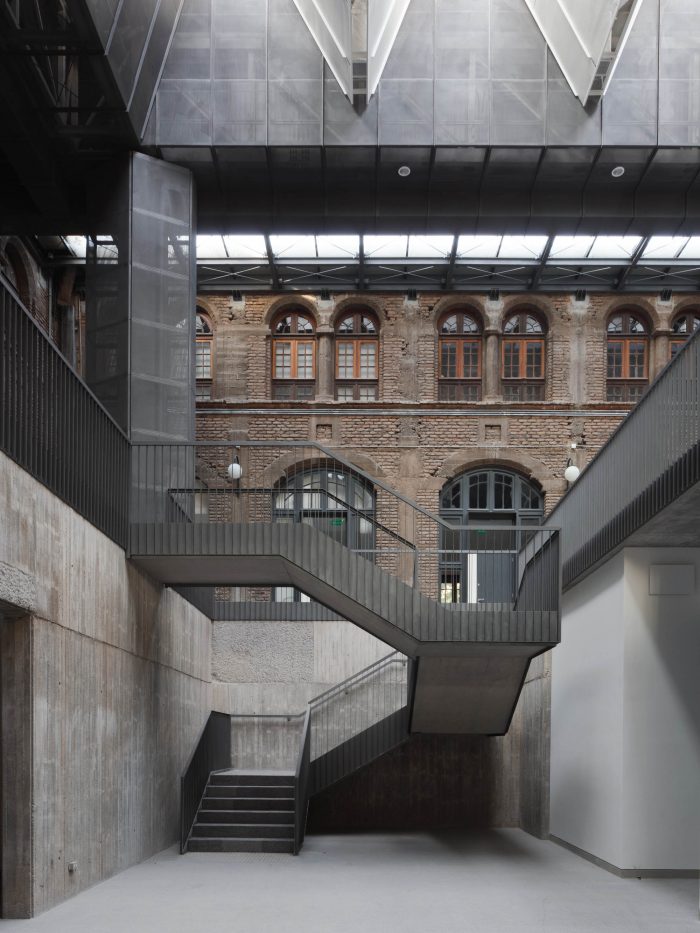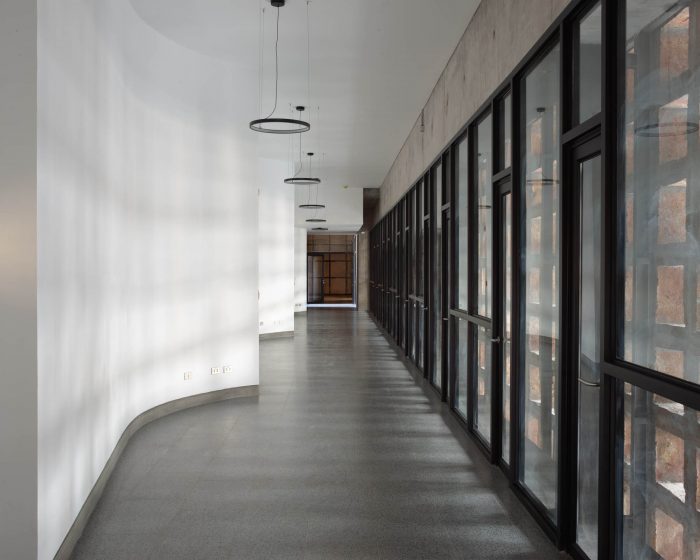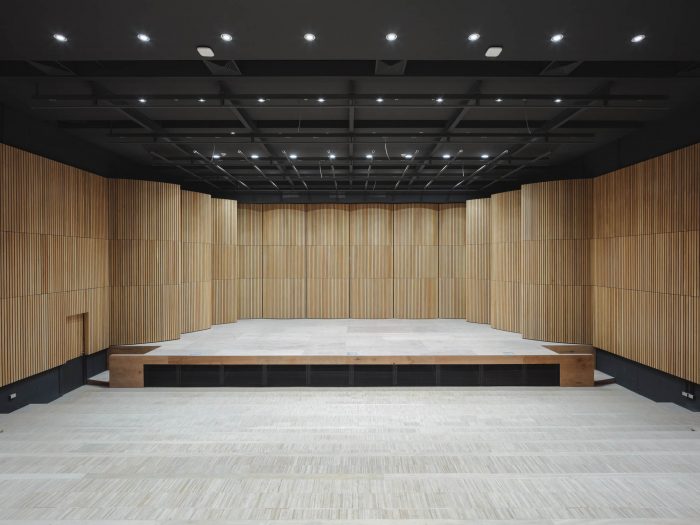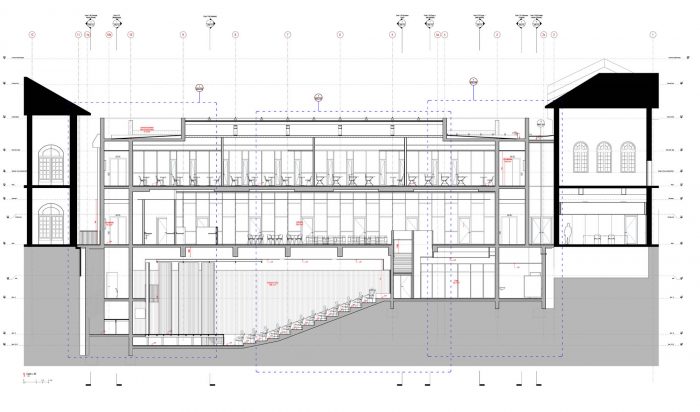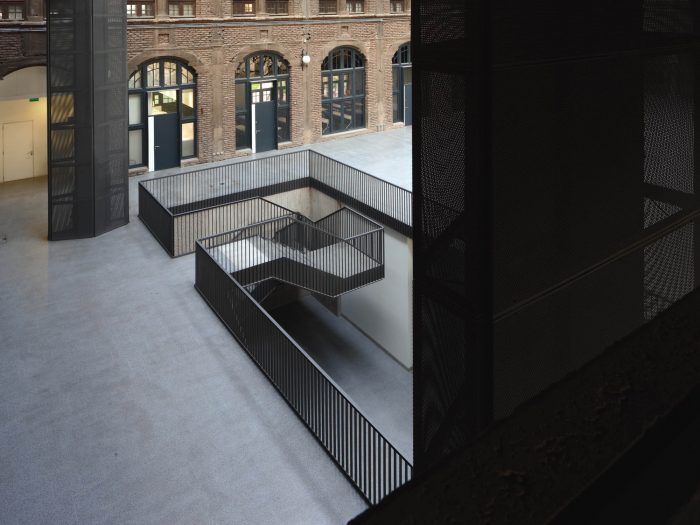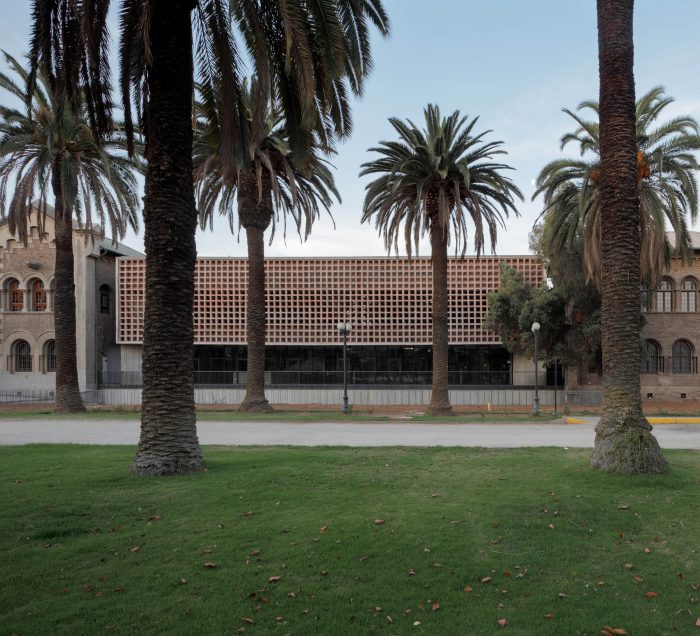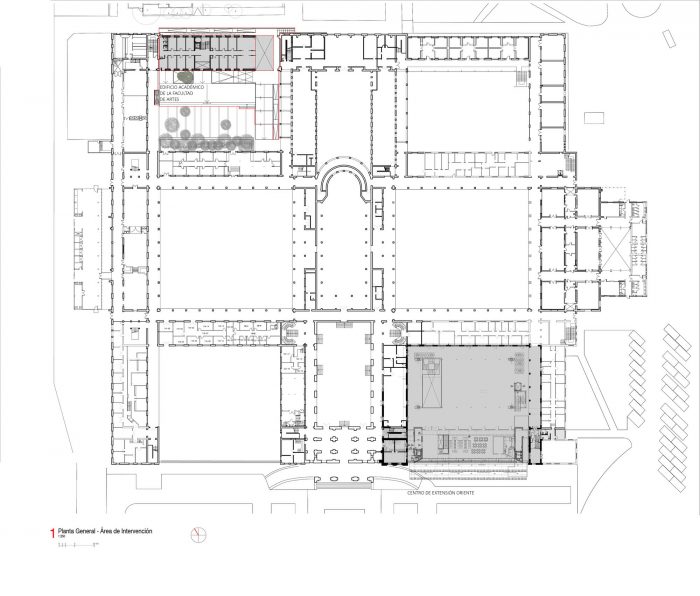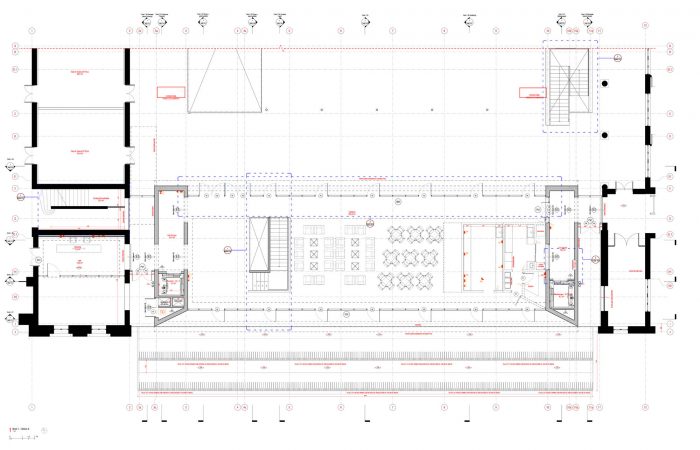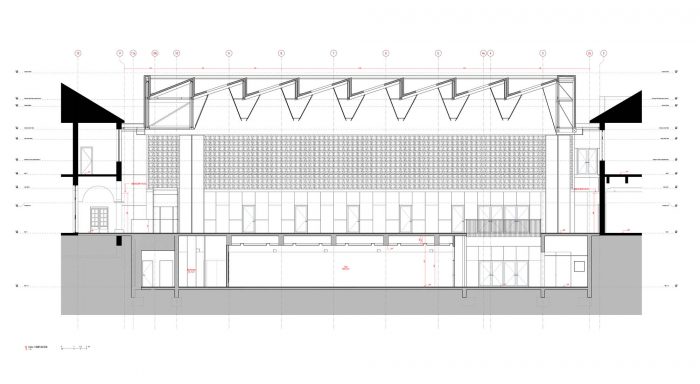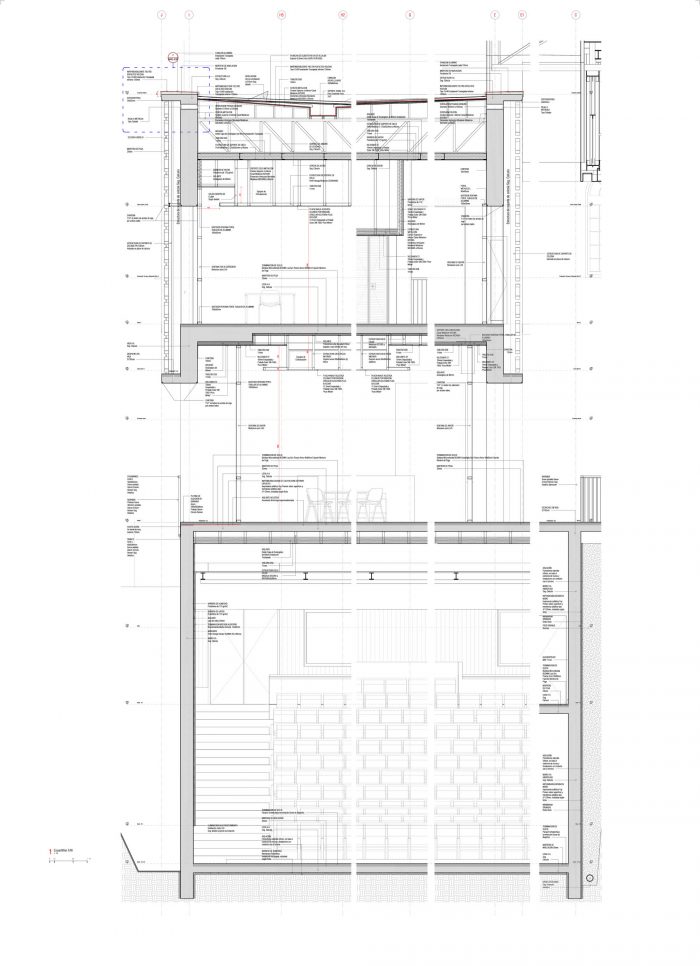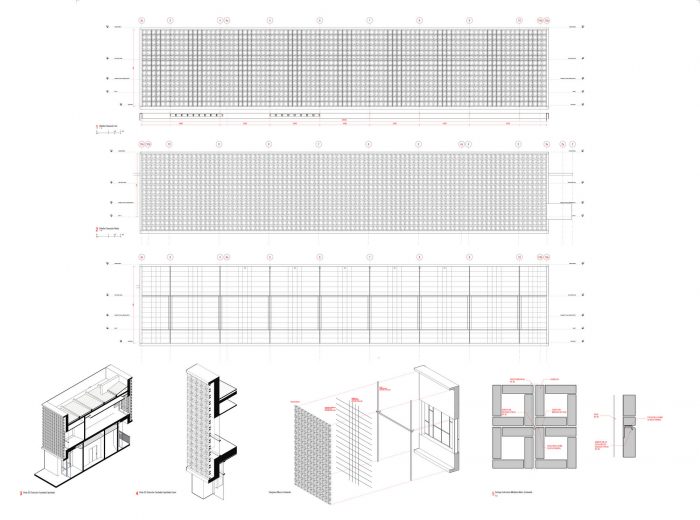东部扩展中心的外立面和有盖庭院建筑项目是2013年委托实施的更大计划的一部分,该计划建议赋予智利天主教大学东部校区的建筑群以新的生命并融入新的功能。原项目属于胡安-里昂和路易斯-阿索卡尔,建于1930年左右。围绕着最初的计划,各种局部订单被衔接起来。现在轮到艺术学院的教学楼和旧楼的两组房间的改造。伴随着这些干预的基本问题是如何与一栋近百年历史的建筑合作,其材料、砖块和混凝土以及其古老的空间在用户中享有很高的声誉。
The project for the Facade and Covered Courtyard Building of the Eastern Extension Center is part of a larger plan, commissioned in 2013, which proposed to give new life and incorporate new functions to the built complex of the Eastern Campus of the Pontifical Catholic University of Chile. The original project belongs to Juan Lyon and Luis Azócar and was built around 1930. Various partial orders were articulated around the original plan. Now was the turn for the Academic Building of the Faculty of Arts and the remodelling of two groups of rooms of the old building. The fundamental question that accompanied these interventions was how to work with a building close to one hundred years old, whose materiality, brick and concrete, and whose venerable spaces enjoyed considerable appreciation on the part of its users.
出于实际的原因,原则上,任何风格上的模仿都被摒弃了,因为这不仅难以正确地进行,而且作为一种干预历史建筑的策略也是非常可疑的。取而代之的是,我们选择了与老建筑在材料和尺寸上保持一致,将简单砌筑的厚墙与混凝土板、柱子和拱门相结合。这成为了第一条规则:建筑将基本由混凝土和砖组成。后者将以其手工版的方式使用,就像老墙一样。在这种材料的共鸣中,我们增加了使用旧建筑的同族测量,这是从一个非常严格的4.20米的模块化网格中得出的。
For practical reasons and in principle, any stylistic imitation was discarded, which not only would have been difficult to carry out properly but would also be highly dubious as a strategy to intervene with a historic building. Instead, a material and dimensional sympathy was chosen towards the old building, which combines thick walls of simple masonry, with concrete slabs, columns and arches. That became a first rule: the building would basically consist of concrete and brick. The latter would be used in its artisanal version, as in the old walls. To this material sympathy, we add the use of the same family of measurements from the old building, which are derived from a very rigorous modular grid of 4.20 meters.
这种感觉上的共鸣建立了新旧之间共存的秘密纽带。客户的订单要求用新建筑封闭校园的东南庭院。在这个地方,里昂和阿索卡项目提出了一个从未建成的侧翼。外立面建筑是这个侧翼的现代版,它尊重了主要的海湾,并将其融入到校园的循环系统中。
That mensural resonance established secret bonds of coexistence between the old and the new. The client’s order entailed closing the south-east courtyard of the campus with a new building. In that place, the Lyon and Azócar project proposed a wing that was never built. The Façade Building was conceived as a contemporary version of this wing, respecting the dominant bays and integrating it into the campus circulation system.
该项目分两个阶段开发。第一个阶段是外立面建筑本身,这是最初的委托。当这个配置完成后,要求将庭院覆盖起来。几十年来,这个院子一直被金属栅栏封闭着,使得从室内到街道的视觉连续性。我们认为,这种视觉上的连续性不是原项目的一部分,而是随着时间的推移而获得的,应该得到尊重和保留。出于这个原因,新的主体被设想为一个建筑桥梁,允许在第一层完全透明,节省了近30米的光线。一个大型的砖格子,消解了旧建筑的空体关系,是立面的主导元素,它看起来像一种悬浮的砖织物。
The project was developed in two phases. The first one, the Facade Building itself, was the initial commission. When this was configured, the courtyard was requested to be covered. This had been closed, for decades, by a metal fence, allowing visual continuity from the interior to the street. We consider that this visual continuity, which was not part of the original project but had been gained over time, should be respected and preserved. For this reason, the new body was conceived as a building-bridge that allowed total transparency on the first level, saving almost 30 meters of light. A large brick lattice, which dissolves the void-body relationships of the old building, is the dominant element of the façade, which appears as a kind of suspended brick textile.
院子的盖板被构思成一个独立的作品,作为一种四条腿的高原。光线和阳光的进入被仔细地测量,以达到一个合适的气候。一个半透明的折叠式天花板丰富和改变了光线的通道。
The courtyard cover was conceived as an autonomous piece, as a kind of four-legged plateau. The access of light and sun was carefully measured to achieve a suitable climate. A semi-translucent folded ceiling enriches and varies the access of light.
虽然位于校园的一小部分,但该项目希望对其建筑质地进行彻底的改造。它产生了新的连续性,避免了庭院的过度分割,这是其作为一所学校的原始条件的特点。新与旧的共存,以及向公众开放和为大学保留的东西,不仅是一种和谐的毗连或和平的共存。融入整体的碎片认识到了过去的元素,并在其中看到了过去的元素。这就产生了一种新的有机体,其中来自过去的东西获得了新的存在和活力。
Although located in a smaller fraction of the campus, the project aspires to a radical transformation of its architectural texture. It generates new continuities avoiding the excessive division of the courtyards, characteristic of its original condition as a school. The coexistence of the new and the old, as well as that of what is open to the public and what is properly reserved for the university, is not only a harmonious contiguity or a peaceful coexistence. The pieces that are incorporated into the whole recognize the elements of the past and are seen in them. This gives rise to a kind of new organism in which what comes from the past acquires a new presence and vitality.
建筑师:Arquitectura DESE UC
面积:2992平方米
年份:2020年
摄影 : Felipe Fontecilla
制造商:AutoDesk, KEIM, Isover, Knauf, Budnik, DANOSA, Funder Max, INGMAC, Nuprotec, Renner, Schwarz Haus, Transve
独立架构修订:Gerardo Sepúlveda
独立工程修改:Hans Becks
东部扩展中心:Alejandra Carrazana
东校区行政:Yasna Mera
Plinths and Shoring:Lucy Magaña, Gonzalo Magaña
工程师:Sergio Contreras y Asociados
工程顾问:Sergio Contreras, Víctor Palma, Nicolás Gotschlich
建筑:R&R Construcciones Ltda. Alejandro del Puerto, Javier Torres, Rubén Orellana, Aníbal Henríquez
卫生:Instaco – Patricio Moya, Ruz y Vukasovic – Marcelo Toro, Rodrigo Aguilera
电气:COBE Ingenieros – Pablo Oyola
能源:Waldo Bustamante、Gonzalo Escobar
气候装置:Manuel Gutiérrez (1@20grados.cl)
灯光:Catalina Harasic
声学:Absorbe – Verónica Wulf, Roberto Beltrán
剧院:Ramón López Cauly
合作者:Juan Eduardo Ojeda
牵头建筑师:Fernando Pérez Oyarzun, José Quintanilla Chala
设计团队:Rocío Ballesteros, Macarena Burdiles, Juan Pablo Corral, Mónica Flores, Manola Ogalde, Nicolás Yopo
客户:Dirección de Infraestructura UC: Tomás Dalla Porta, Rafael Núñez, Francisco Palacios, Marcela Flores, Álvaro Leiva
城市:Providencia
国家:智利
Architects: Arquitectura DESE UC
Area: 2992 m²
Year: 2020
Photographs: Felipe Fontecilla
Manufacturers: AutoDesk, KEIM, Isover, Knauf, Budnik, DANOSA, Funder Max, INGMAC, Nuprotec, Renner, Schwarz Haus, Transve
Independent Architecture Revision:Gerardo Sepúlveda
Independent Engineering Revision:Hans Becks
East Extension Centre:Alejandra Carrazana
East Campus Administration:Yasna Mera
Plinths And Shoring:Lucy Magaña, Gonzalo Magaña
Engineers:Sergio Contreras y Asociados Consultores de Ingeniería: Sergio Contreras, Víctor Palma, Nicolás Gotschlich
Construction:R&R Construcciones Ltda. Alejandro del Puerto, Javier Torres, Rubén Orellana, Aníbal Henríquez
Sanitary:Instaco – Patricio Moya, Ruz y Vukasovic – Marcelo Toro, Rodrigo Aguilera
Electric:COBE Ingenieros – Pablo Oyola
Energy:Waldo Bustamante, Gonzalo Escobar
Climate Installations:Manuel Gutiérrez (1@20grados.cl)
Lightning:Catalina Harasic
Acoustic:Absorbe – Verónica Wulf, Roberto Beltrán
Theater:Ramón López Cauly
Collaborators:Juan Eduardo Ojeda
A Lead Architects:Fernando Pérez Oyarzun, José Quintanilla Chala
Design Team:Rocío Ballesteros, Macarena Burdiles, Juan Pablo Corral, Mónica Flores, Manola Ogalde, Nicolás Yopo
Clients:Dirección de Infraestructura UC: Tomás Dalla Porta, Rafael Núñez, Francisco Palacios, Marcela Flores, Álvaro Leiva
City:Providencia
Country:Chile


